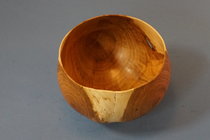I turned a combo salt shaker / pepper mill from Red Elm. I sanded to 800 then used shavings to burnish the wood giving it a nice luster.
I then applied a flood coat of Natural Danish Oil, waited 15 minutes and applied another. After 15 more minutes I wiped off all I could. Perhaps it was the burnishing but neither coat seemed to penetrate much.
It's been 4 days now and it still feels oily to the touch. And I continue to wipe it down.
Shouldn't this have cured by now?
I'm wondering if it ever will?
Where should I go from here?
Thanks in advance for all your thoughts.
I then applied a flood coat of Natural Danish Oil, waited 15 minutes and applied another. After 15 more minutes I wiped off all I could. Perhaps it was the burnishing but neither coat seemed to penetrate much.
It's been 4 days now and it still feels oily to the touch. And I continue to wipe it down.
Shouldn't this have cured by now?
I'm wondering if it ever will?
Where should I go from here?
Thanks in advance for all your thoughts.

